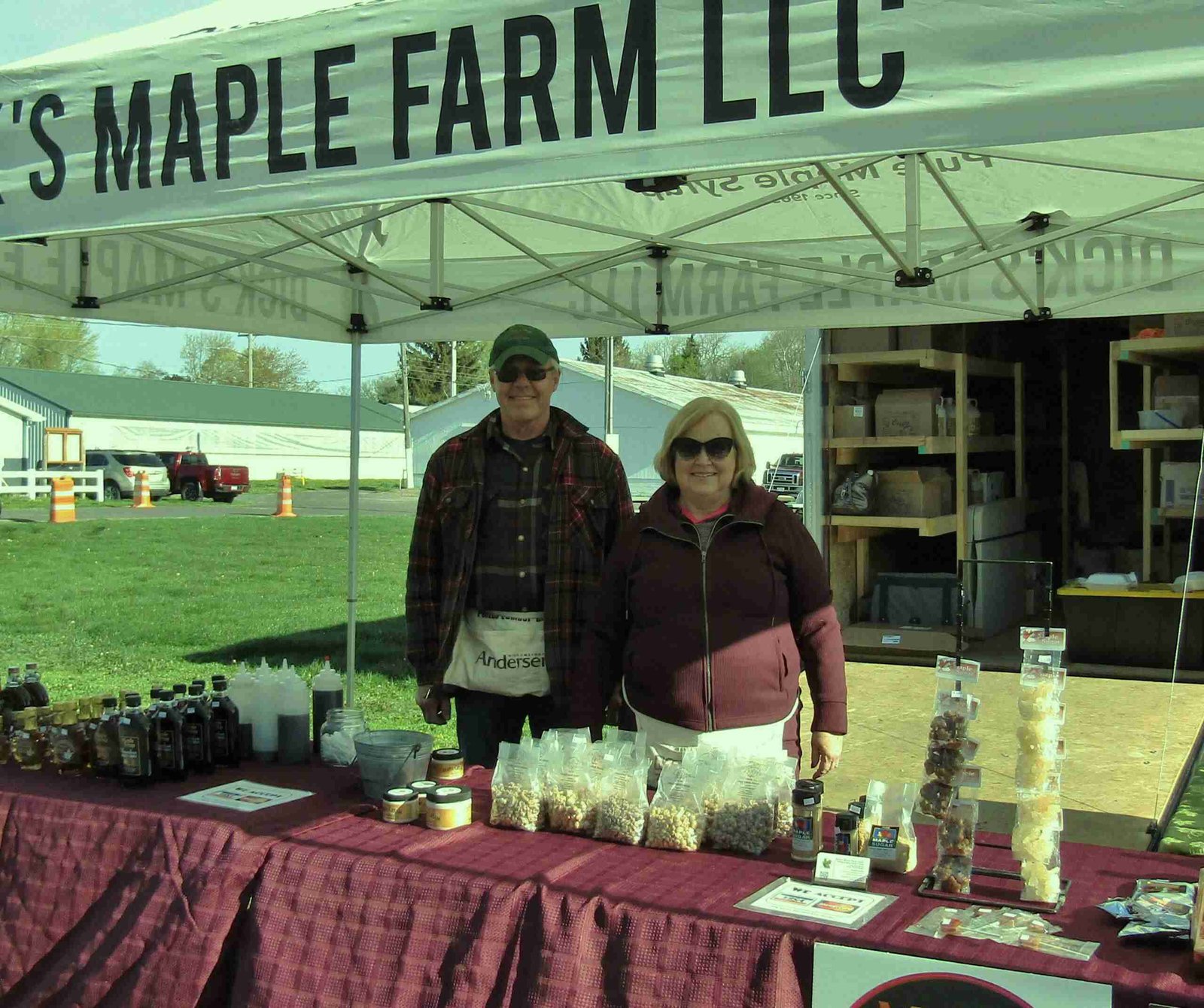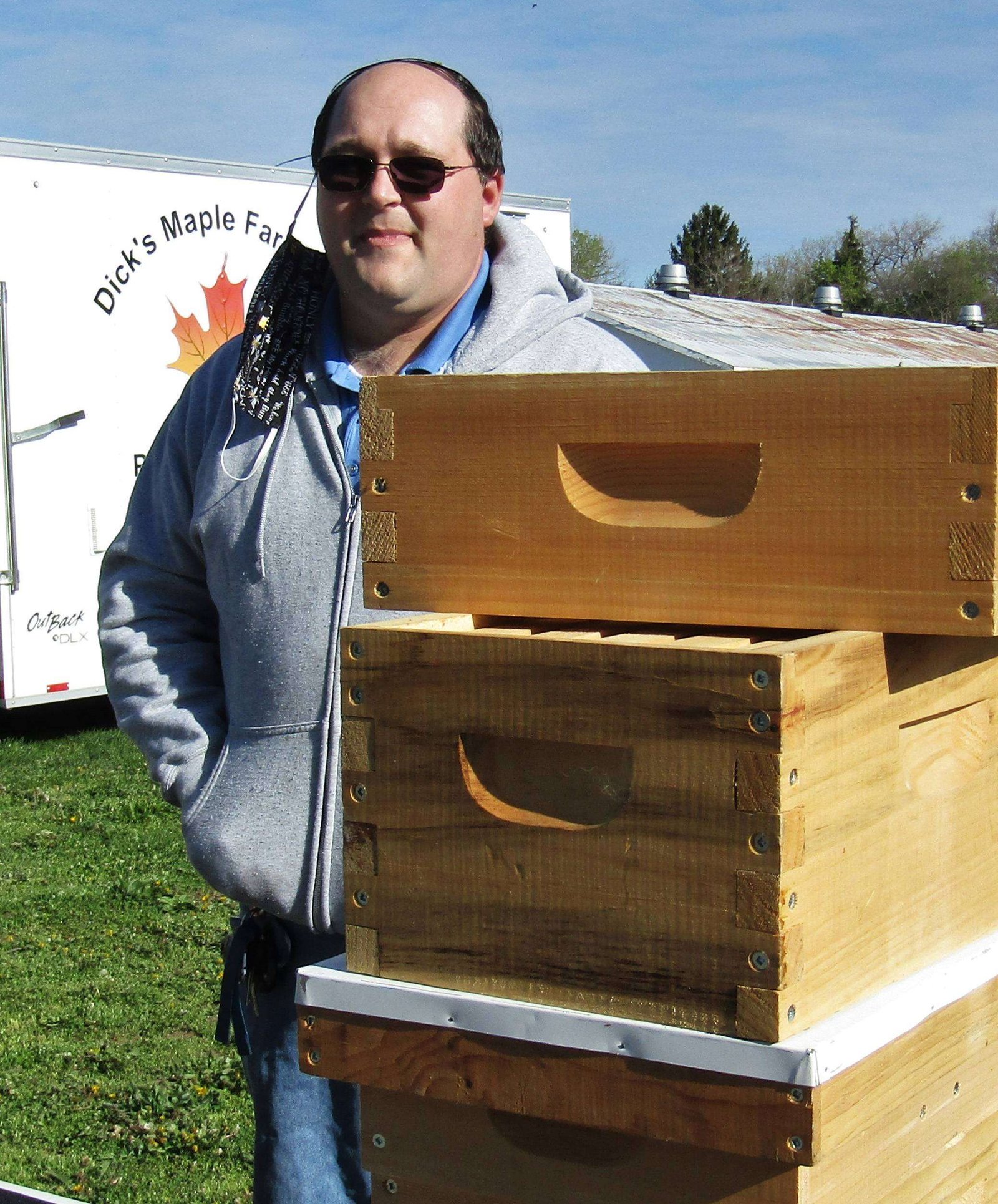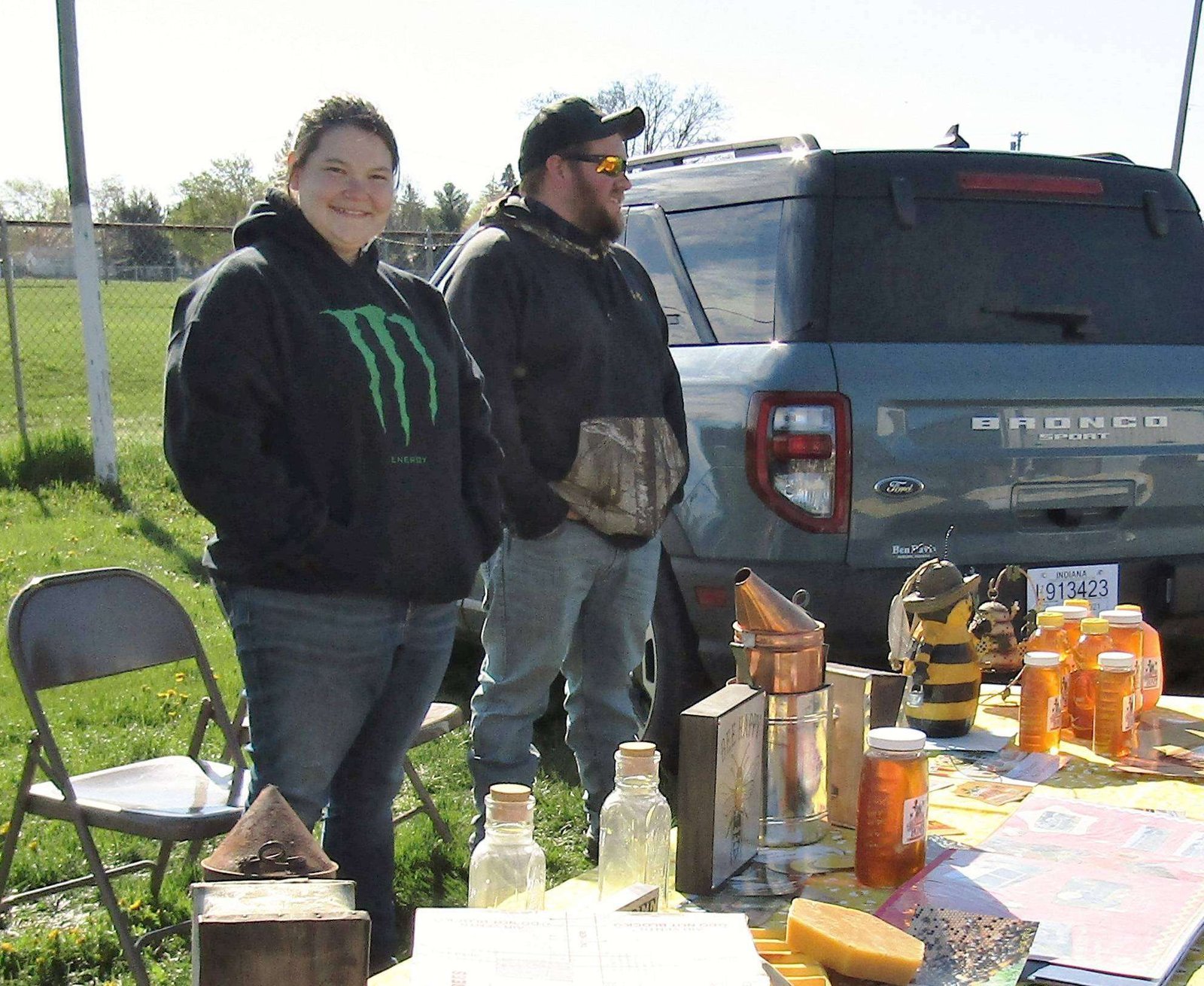
Lamar & Pam Dick (PHOTOS BY LEANN CHILDRESS, STAFF)
By: LeAnn Childress
Imagine … Pure Maple Syrup, hot, fluffy pancakes with sausage patties on the side. Does it sound delicious? It was very delicious and it was available at the annual Pancake & Sausage Breakfast with Pure Maple Syrup that took place at the Williams County Fairgrounds in Montpelier, Ohio on Saturday May 1, 2021.
Anne Marie Michaels, who assisted with setting up the breakfast and the vendors and also directed attendees to featured areas said, “The Williams County Fair Foundation sponsors and makes the breakfast and the Northwest Ohio Maple Syrup Producers planned the whole event.
Michaels shared that the average attendance is around 2,000 people but it is much smaller this year due to COVID.
Next year they are estimating that the turn out will meet the average attendance in past years. Under normal circumstances the Pancake & Sausage Breakfast with Pure Maple Syrup Festival is always held on the 4th Saturday in March and this will resume next year for 2022.
The reason for the event being held on the 4th Saturday in March is when the sap is usually flowing. The Maple Syrup Producers started this event and it got so big that it had to be moved to the fairgrounds.
The featured vendors included: Pancake & Sausage Breakfast with Pure Maple Syrup; Maple Syrup Products to Purchase; Fresh Spun Maple Cotton Candy; Kettle Corn From ‘Poppin George’; Wildlife Pelt Display; Taxidermist Display; Beekeeper Bethany (Carlson) Eberly; Black Swamp Beekeepers Association
Lamar Dick of of Dick’s Maple Farm LLC explained the process of tapping maple trees, “It’s in the spring, usually in February and March when the trees start to come out of winter dormancy and the freezing and thawing temperatures will move the sap up and down from the roots up to get ready to grow leaves so that’s when we tap the trees to collect some of that sap.”
“It takes about 50 gallons of sap to make one gallon of syrup. The length of time from getting the sap to having maple syrup to serve varies on how big of evaporators you have.”
“We try to keep it as short as possible because sap is sort of like milk, if you let it sit around too long it will start to turn sour so we make an effort to get it processed as quickly as possible so normally, you’re talking a matter of less than a day, hours.”
“From the tap to consumption we remove water, all we do is remove water, first by reverse osmosis to take out a lot of the water so we don’t have to use so much fuel oil or wood to boil it and then remove the rest of it by evaporation when you boil it.”
“We don’t ever add anything, it’s all 100% natural, we just remove water. That’s all you do to make maple syrup out of maple sap is just remove water.”
Dick goes on to say, “They have four different colors, everything is considered Grade A but you have Golden, you have Amber, Dark, and Very Dark colors of syrup. Typically, you get lighter syrup earlier in the season and darker syrup later in the season.”
“The sugar content is always the same and the sweetness is the same regardless of the color but the darker the color the stronger the maple flavor. For cooking purposes we typically recommend either the dark or very dark because more of the maple flavor will stay with whatever you’re cooking.”
Pam Dick added, “Besides just maple syrup there is now cinnamon syrup that is maple syrup flavored with cinnamon sticks. The bourbon is flavored in a bourbon barrel and it’s great for meat products.”
Dick also said, “It’s all 100% natural and they are finding a lot of health benefits from it. They are finding it’s good for arthritis and it helps to prevent alzheimers. The more research they do the more they find out how good natural stuff is for you.”
Mark Dye of Dye’s Sugarbush has been in the business of making maple syrup for about 40 years and he stated, “This year we had a real short season. Normally we can have 4 to 6 weeks but this year we had probably less than 2 weeks. [It was most likely due to the weather], I think it had something to do with being so dry.”
“The only reason you’d get bad syrup is if you tapped too long and once the trees bud you don’t want to be processing that sap because it won’t taste right.
The syrup can be different from year to year with the same producer. There’s at least 3 different flavors of syrup (on the table) here, it just depends on when you make it during the season.” For more information you can go to, YouTube: Maple Syrup Tapping with Mark Dye

Chris from Black Swamp Beekeepers Association
Chris from Black Swamp Beekeepers Association out of Defiance County said, “We’re here to educate people on beekeeping, best practices in beekeeping. A lot of people lose their bees or don’t realize that bees hibernate over winter so they think that having to purchase bees every year is the common theme and it actually shouldn’t be.”
“We teach sustainability through a couple of different things, we have a pollinator sanctuary in Defiance County and it’s a training facility as well. When it was built it was the only one in the state and certified by OSBA as a training facility. If people want to come and see a working hive and how an apiary works we will do sponsored tours of the training facility.”
“We’re here teaching everybody what a hive looks like, whether it’s a brood box or a honey super, talking about queens, and things that have to do with the hive. The brood super is where the queen is going to lay all of her eggs and where all of the other bees are going to be born and emerge.”
“In a normal frame there are 8,000 holes, once the bees have this all drawn out per side, that’s 16,000 new bees that can be laid, per frame, and in a normal hive there’s 10, so if you calculate that out that’s quite a few bees. The bees will emerge 21 days after she lays an egg.”
“The queen emerges in 16 days and the drones, which are the males for mating, will emerge in 24 days and all of that is done in the brood super unless she doesn’t have space and then she’ll move into the honey super which the frames are a lot shorter but once they build it out they will fill it full of honey and cap it, it’s not honey until it’s capped.”
“Until it’s capped it’s called nectar because it’s not dried down to the point of 18.1% moisture or lower so if it’s open nectar the moisture’s too high and it can mold easily so the bees have to dry it down and cap it. Once it’s capped it’s ok to spin out and put into a jar.”
Chris continues with talking about beekeeping safety, “It’s a major priority here. We have all types of gear to help protect you and a lot of people use a full suit that cover from head to toe (which was displayed), a lot of people just wear a jacket and there are the select few that just wear the veil to protect the face because if you get stung in the eyeball, in 30 minutes the venom from the bee will eat out the cornea and you will be blind in that eye.”
“Whenever messing with bees make sure that you have face protection on because that’s where they are going to go first to get your attention to get you away.”
Chris voiced his concerns about the decline of the bee population by saying, “Ohio had a 70% loss of bees last year which is not a good loss rate. Beekeepers need to know what pests they have and what’s out there bothering your bees.”
“Make sure you have enough forage around for them to eat and to make sure they have enough resources so they don’t starve over the winter and sugar water is not a good source of food.”
“Pesticides and herbicides have been a lot of the contributing factors in the declining bee population and so have pests. The very first pollinators for the bees, if the trees aren’t out yet, are the dandelions and many people spray their yards for a dandelion-free lawn.”
Bethany and Tyler Eberly with Liberty Honey: Bethany said, “I have been keeping bees since I was 14 in Williams County and I’ve been selling honey for over 10 years now. This is one of my favorite shows because it’s an educational show instead of just selling honey.”
“Usually there’s a lot more kids and we like to go through a show the kids’ pictures of the queens and the bees. Probably the coolest thing about us is that we go to Florida and we take our bees and they make orange blossom honey bee pollinating orange trees. They also pollinate watermelons and the Eberly’s get paid for this because so many crops depend on the bees for pollination, they pay per hive.
Bethany continued to say, “A lot of people send their bees to California to pollinate almonds because almonds are 100% dependent on bee pollination. Beekeepers can make several hundreds of dollars per hive to send their bees to California.”
The Eberlys prefer to stay with and watch over their bees so they do not send their bees to California but they have friends who do.
Bethany talked further about California’s almond business saying, “It’s so cut-throat to get bees into a property and get paid for them. Bees are such a high commodity that bees get stolen a lot. [Bee thieves] come in during the evening when no one is around and take out bulk frames in the middle of the hive where the queen and the babies are and put them into an empty box.”
“Bee stealing really isn’t a problem here. Cattle pastures are the best places around here to keep bees because of the clover and dandelions.”

Tyler & Bethany Eberly
“One of the biggest dangers to bees in our area are wasps. Wasps like to get into the hives and take the baby bees during the gestation period and take them back to their hives to feed their young.”
Bethany shared, ‘A safety issue for humans is that bees feed off our pheromones so if you are feeling fear or you are having anger issues this will attract bees, as well as not practicing good hygiene.”
As for pheromones, Bethany continued to say, “The queen carries a unique pheromone and this is how the bees find their hive.”
Joe Blosser (Hunter & Trapper) Representing Josh Burkholder (Taxidermist – not present) explained, “One process of the art of taxidermy is to freeze dry the animal by putting small holes in the deceased animal to release gases and then put the animal into the desired position and placing it into the freeze dryer for up to 6 months.”
Blosser said, “Burkholder will work on any animal and he’s worked on moose, and african exoctics.” You can contact Josh Burkholder at 419-782-9538.
Blosser said about himself that he has been hunting and trapping for most of his life and that he has taken many animals to Burkholder.
Blosser went on to say that he hunts is due to overpopulation of animals and also because he enjoys being outside and the challenge of the hunt.
Blosser continued by saying, “Coyotes are the most difficult animal to trap because they are so smart. They can easily smell the scent of other animals and humans, and they are dangerous.
One of the first recorded deaths in a suburb was in 1974 in California when a coyote climbed over a fence and into a backyard where a little girl was playing and grabbed her by the neck.”
“A similar situation happened in Massachusetts to a young boy, both states were among the first to outlaw steel leg-hold traps.”
Blosser shared his favorite animal, “The opossum is my favorite animal because they are multifaceted and their skeletal structure hasn’t changed since the dinosaur age.”
“An opossum can have 20 to 25 babies at one time but only 13 survive because the mother’s physical structure can only accommodate that many to feed.”
“The opossum releases a chemical in its brain that causes it to freeze when faced with danger and it can not move. Also, they do not hang by their tails because they don’t have the bone structure to support their weight.”
Being new in the newspaper writing industry I am realizing that some assignments will be highly educational. Being assigned to the maple syrup festival was definitely one of them as I learned something new regarding subjects ranging from Beekeeping to Taxidermy.
I highly recommend putting this event on your schedule for next year. Oh, did I mention that there’s maple syrup and pancakes & sausage? Yum! And, you can learn how to make maple syrup too!
LeAnn can be reached at publisher@thevillagereporter.com
